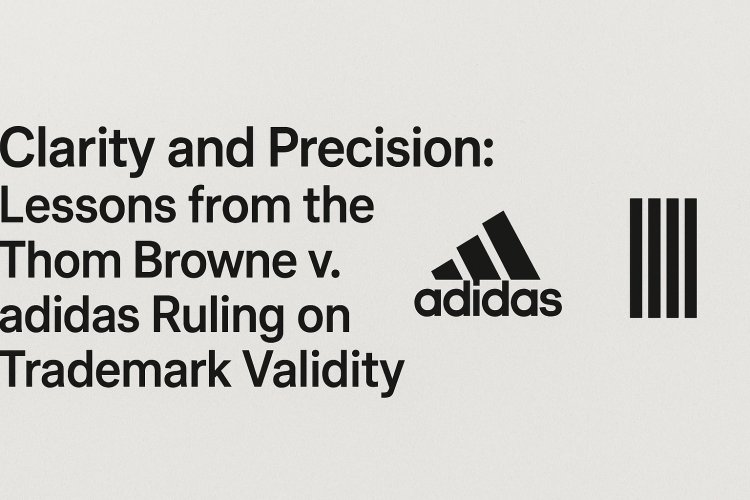Clarity and Precision: Lessons from the Thom Browne v. adidas Ruling on Trademark Validity
The Court of Appeal’s decision in Thom Browne Inc and Thom Browne UK Ltd v adidas AG underscores the vital role of clarity and precision in trademark registration. By invalidating adidas’s three-stripe position marks for lack of specificity, the court reaffirmed that ambiguous or overly variable representations cannot constitute a single, enforceable trademark. This landmark ruling provides critical guidance for brands seeking to protect their visual identities under UK trademark law.

Introduction
The legal landscape surrounding trademark registrability is constantly evolving, with recent cases shedding light on the boundaries of distinctiveness and clarity required for trademark protection. One such pivotal case is Thom Browne Inc and Thom Browne UK Ltd v adidas AG, [2025] EWCA Civ 1340, decided by the Court of Appeal (Civil Division) of England and Wales on October 23, 2025. This decision not only addressed important issues related to trademark validity but also reinforced the principles that govern the registration of position marks in the UK. This case stemmed from adidas AG's attempts to defend its six registered trademarks, all centred on the iconic three-stripe design associated with its apparel. The trademarks in question were applied to various garments and were registered in 2003. The core of the dispute revolved around whether these position marks were valid, specifically addressing whether they fulfilled the necessary criteria to be registered as trademarks under the Trade Marks Act 1994 and relevant EU directives. The High Court had previously ruled in favour of Thom Browne, declaring that adidas’s marks were invalid. The findings highlighted that the registrations did not represent a single sign but rather a multitude of potential variations that lacked the requisite clarity and precision. Dissatisfied with this outcome, adidas appealed the decision to the Court of Appeal, setting the stage for a critical examination of trademark law.
Details of the marks of adidas are below.
|
Mark |
Registration No. |
Class |
|
|
00903517588 |
25 |
|
|
00002327095 |
25 |
|
|
00903517661 |
25 |
|
|
00002327093 |
25 |
|
|
00903517612 |
25 |
|
|
00002327092 |
25 |
The Core Issues at Stake
At the heart of the appeal were two primary legal issues regarding the registrability of the six adidas three-stripe trademarks:
· Lack of Clarity and Precision: The legality of the trademarks was questioned based on whether the representation provided by adidas was sufficiently clear and precise to determine the scope of protection.
· Multiplicity of Signs: The trademarks need to be viewed as a single, cohesive mark rather than a collection of varying designs that could lead to consumer confusion.
The Court of Appeal was particularly tasked with determining whether the descriptions of the trademarks allowed for too many variations, thereby compromising their validity under the specific legislative framework.
To know more about this you can follow the link below:
The Court's Findings
The Court of Appeal upheld the High Court's ruling, confirming that the marks were indeed invalid. The reasoning was based on three cumulative conditions that must be satisfied for a trademark to be validly registered: the existence of a recognizable sign, a clear graphic representation, and the necessity for the mark to function as a means of distinguishing goods or services. In this instance, the court found that the first two conditions were unmet. The Court's analysis highlighted that the wording used by adidas, specifically the phrase “one third or more”, did not establish fixed parameters for the trademark. This lack of specificity permitted a wide range of unrepresented variants, allowing the stripes to be applied in numerous ways that deviated significantly from the pictorial representation. As a result, the registrations were deemed to cover multiple signs rather than a single, coherent sign.
Key Reasoning from the Ruling
The ruling underscored several important legal principles and precedents, which included:
· Distinctiveness through combination: Position marks derive their distinctiveness from the interplay between their visual elements and their designated positions. The court emphasized that when descriptions allow for significant variability, they undermine the mark's ability to function as a singular source identifier.
· Uncertainty and Competitive Advantage: The broad scope of adidas's descriptions created uncertainty regarding the actual mark protected. This could lead to an unfair competitive advantage, violating existing principles established in various landmark cases, including C-273/00 Ralf Sieckmann v Deutsches Patent und Markenamt [2002], C-104/01 Libertel Groep BV v Benelux-Merkenbureau [2003], and C-321/03 Dyson v Registrar of Trade Marks [2007].
· Evidence of Use and Acquired Distinctiveness: The court determined that evidence of use and acquired distinctiveness could not remedy a fundamental failure to satisfy the definition of a registrable sign. Such evidence is logically secondary and cannot compensate for an initial lack of clarity and precision.
Grounds of Appeal and Their Rejection
adidas presented several grounds for appeal during the proceedings, all of which were ultimately rejected by the court. Some of the main arguments included:
· Misinterpretation of Precedents: adidas argued that there was a misinterpretation of the existing case law, particularly the Dyson case. However, the court affirmed that the High Court did not treat unrepresented variants as an automatic bar but rather aligned the interpretation with established legal principles.
· Overstatement of Variability: The appeal contended that the High Court overstated the significance of variability. The Court rejected this, affirming that even without considering additional design variations, the inherent variability in the registered marks was sufficient to negate their registrability.
· Ambiguity of Language: The claim regarding the ambiguity of the phrase “one third or more” was also dismissed. The ruling stated that while the term may appear clear linguistically, its practical implications combined with broader descriptions resulted in a lack of requisite precision.
· Visual Differences versus Origin Perception: adidas’s argument that visual differences were being overemphasized without considering the origin impact was deemed unfounded, as the High Court had adequately assessed the public's perception of the marks.
Practical Implications for Trademark Registration
The outcome of this case carries significant implications for brand owners and companies seeking to register trademarks, particularly position marks. Here are some key takeaways:
· Need for Precision: Companies must ensure that their trademark applications define the position and representation of marks with precision. Avoiding open-ended phrases that lack fixed parameters is crucial.
· Consistency is Key: Written descriptions and pictorial representations should be aligned to avoid creating ambiguity that could invalidate a trademark claim.
· Series of Marks for Variability: If a business requires multiple variations, it may be prudent to file a series of tightly defined marks rather than attempting to cover broad claims in a single application.
· Acquired Distinctiveness: Brands should not rely on evidence of acquired distinctiveness to address deficiencies in the accuracy and clarity of their trademark applications.
Conclusion
The case of Thom Browne Inc and Thom Browne UK Ltd v adidas AG sets a significant precedent in trademark law, particularly regarding the registration of position marks. The Court of Appeal's endorsement of the High Court's findings reinforces the importance of clarity, precision, and the prevention of ambiguous trademarks that can lead to consumer confusion. As businesses navigate the complexities of trademark registration, the principles established in this case will serve as a vital guide for ensuring robust intellectual property protections while maintaining fair competition in the marketplace. In a world where brand identity is paramount, the implications of this ruling resonate strongly not just with adidas but with any entity looking to secure their trademarks in an increasingly competitive landscape.












